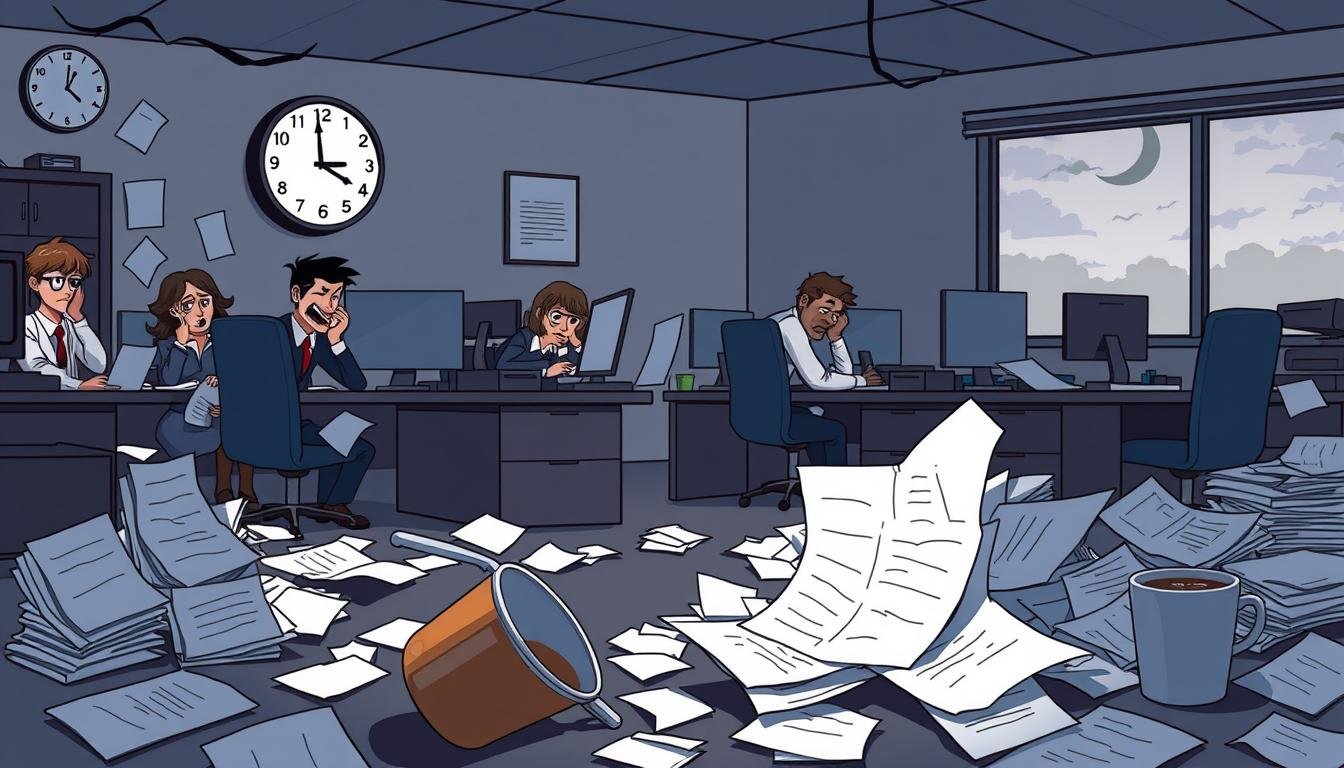Work-Related Stressors: The Hidden Organizational Challenges You Need to Tackle
Is your workplace silently harming your health and work performance? Today’s fast-paced business world has made workplace stress a big problem. It affects both your health and your company’s success. With 83% of U.S. workers stressed every day, it’s time to find out what’s causing it.
Many workplace challenges are hidden but hurt our well-being and job satisfaction. Things like too much work and bad work-life balance lower our productivity and happiness. The American Association of Psychology says 87% of employees think their bosses can help their mental health. But are companies listening?
Ignoring these issues costs a lot. Workplace stress in the U.S. leads to over 120,000 deaths each year and costs about 5-8% of our healthcare budget. With $300 billion lost due to being absent, not working well, and accidents, it’s clear we must act. Fixing these problems is not just about making employees happy. It’s crucial for business success.
Let’s explore the causes of work-related stress, their effects, and how to make work better. Are you ready to face the hidden challenges that slow down your company?
Key Takeaways
- 83% of U.S. workers experience daily work-related stress
- Workplace stressors cause over 120,000 deaths annually in the U.S.
- Poor work-life balance significantly affects employee health and performance
- Overwhelming workloads can lead to burnout and decreased job satisfaction
- Addressing workplace stress can save companies billions in healthcare costs and lost productivity
- 87% of employees believe their employers can take action to improve mental health
Understanding the Impact of Workplace Stress
Workplace stress is a big problem today. It hurts how well employees do their jobs and their happiness. This also costs a lot of money for companies.
The Prevalence of Stress in Modern Work Environments
Stress at work is very common. In the UK, 440,000 people said work stress made them sick. This led to 9.9 million lost workdays in 2014/2015.
The rate of work-related stress was 1380 per 100,000 workers. An even higher rate of 740 per 100,000 workers was seen.
How Stress Affects Employee Performance and Well-being
Long-term stress at work can really hurt how well people do their jobs. It can also make them sick. The Centers for Disease Control says it can cause headaches, insomnia, and more.
These problems make it hard to work well and be happy at work.
The Economic Impact of Workplace Stress on Organizations
Stress at work costs companies a lot of money. In 2013/2014, it cost the British economy £14.3 billion. Public services paid even more, £1.2 billion a year.
This money goes to things like less work done, more days off, and people leaving their jobs.
But, if companies help with mental health, many workers want to stay. This shows how important it is to deal with stress to keep a good team.
Common Sources of Work-Related Stressors
Work-related stress is a big problem for many workers in different fields. In the United States, 83% of employees face job stress. It’s important for both workers and bosses to know what causes this stress.
Role ambiguity is a big stressor. When jobs are unclear, workers struggle to do well. This confusion can make them doubt themselves and work less efficiently. In fact, 43% of workers are worried about keeping their jobs, showing the need for clear job descriptions.
When a worker’s values don’t match the company’s culture, it can cause stress. This mismatch often leads to a bad work environment. It makes 32% of workers leave their jobs.
Work overload is also a big problem today. When jobs are too much, workers can get burned out. Long hours have been linked to depression, showing the need for a good work-life balance.
“Problems at work are more strongly associated with health complaints than any other life stressor – more so than even financial problems or family problems.” – St. Paul Fire and Marine Insurance Co.
Fixing these stressors is key for a better work place. By dealing with unclear roles, cultural mismatches, and too much work, companies can lower stress. This makes workers happier and healthier.
The Role of Organizational Culture in Stress Management
Organizational culture greatly affects how employees feel at work. A positive culture can lower stress and improve well-being. Let’s look at how values, leadership, and communication make a workplace healthier.
Company Values and Stress Levels
Values that focus on employee well-being can reduce stress. A study in India and the UK showed interesting findings:
| Country | Main Stressors | Impact on Stress |
|---|---|---|
| India | Role conflict, overload, ambiguity | Higher |
| UK | Role ambiguity | Lower |
This study shows how different values can affect stress at work.
Leadership’s Role in a Healthy Work Environment
Strong leadership is key to a stress-free workplace. Leaders who manage change well can boost morale. For instance, the Ohio Military Reserve (OHMR) used corporate leadership to motivate and develop soldiers.
Open Communication to Reduce Stress
Open communication lets employees share concerns and get help. This openness can reduce stress, improve job satisfaction, and keep staff longer. A culture that talks openly is more supportive and less stressful.
“A culture of open communication can transform workplace stress into opportunities for growth and innovation.”
By focusing on these aspects of organizational culture, companies can build a stronger workforce. This workforce is better at facing work challenges.
Work-Life Balance: A Key Factor in Stress Reduction
In today’s fast world, finding a balance between work and life is key. This balance helps reduce stress and makes employees happier. Many Americans feel very stressed, with over a quarter saying they are “super stressed.”
Long-term stress can harm our health, even leading to heart attacks. To fight this, companies are focusing on work-life balance. They’ve found that flexible work hours make employees more productive and loyal.
Starting work-life balance programs can really help. Here are some benefits:
- Less stress
- More job satisfaction
- Better mental health
- Higher employee retention
- Improved physical health
A study in 2014 by Haar et al. showed that balance improves job and life satisfaction. Companies like Autogrill, ENEL, and SNAM have great programs. They show they care about their employees’ well-being.
“Employees working flexible schedules are shown to be more productive and loyal to their employers.”
To help balance work and life, companies can support regular exercise. Exercise lowers depression and anxiety. Also, having a strong support system at work boosts health and well-being.
By focusing on work-life balance, companies can make their workforce healthier and more productive. This reduces stress and boosts employee happiness.
Hidden Work: The Unseen Contributor to Employee Stress
Hidden work is a big issue in today’s workplaces. It’s work done outside regular hours without pay. This hidden labor affects how happy and productive employees are. Let’s look into how hidden work impacts stress levels.
Defining Hidden Work in the Modern Workplace
Hidden work means doing tasks outside of work hours without getting paid. It’s things like checking emails late at night or working on weekends. This extra work is often not seen, leading to more stress and burnout.
The Impact of Technology on After-Hours Work Expectations
Technology has made it hard to separate work from personal life. With smartphones and work systems online, we’re always connected. This makes employees feel like they must work all the time, causing stress and imbalance in their lives.
Strategies for Managing Hidden Work and Reducing Stress
To tackle hidden work and its stress, companies can take steps:
- Set clear rules for work emails and calls outside work hours
- Encourage taking breaks from work during personal time
- Give credit and pay for extra work
- Support a good balance between work and personal life
By dealing with hidden work, businesses can make their employees happier and more productive. Using stress management and setting clear work hours can make a workplace healthier.
| Hidden Work Type | Prevalence (%) | Stress Impact (1-10) |
|---|---|---|
| After-hours emails | 78 | 7 |
| Weekend project work | 62 | 8 |
| Uncompensated overtime | 55 | 9 |
| Off-hours client calls | 43 | 6 |
The Connection Between Job Demands and Occupational Burnout
Job demands and stress at work are big reasons for burnout. The COVID-19 pandemic made these problems worse. Now, many jobs are seeing more burnout. This hurts how well people work, their happiness, and their health.
- 40% of workers say their job is very or extremely stressful.
- 26% feel often burned out or stressed by their job.
- 29% experience slight to extreme stress at work.
The pandemic hit healthcare workers hard. A study of 4,621 health workers in Southeast Europe found high levels of emotional exhaustion. Job demands were a big reason, with 37% of the blame.
Around 40% of health workers worldwide got anxiety and depression during the COVID-19 pandemic, creating a ‘pandemic within a pandemic’.
But it’s not just healthcare. Teachers, parents, and others in many jobs feel more stressed and burned out. Things like work-life balance, too much work at home, and how we think about our jobs all play a part.
| Profession | Burnout Factors | Impact |
|---|---|---|
| Healthcare Workers | High job demands, emotional exhaustion | Anxiety, depression, chronic fatigue |
| Teachers | Online instruction, work-family balance | Reduced efficacy, attitude changes |
| Parents | Work-family conflict, quarantine stress | Increased risk of child maltreatment |
To fight burnout, companies need to help with stress. They should support physical and mental health and build strong teams. By tackling job stress, businesses can make a better work place and help their employees feel better.
Promoting Employee Well-being Through Organizational Initiatives
Employee well-being is a big deal for companies today. With 84% of workers saying work affects their mental health, businesses are stepping up. They’re launching stress management programs to help.
Implementing Stress Management Programs
Good stress management programs can really cut down on work stress. They might include workshops on managing time, mindfulness classes, and counseling. This way, companies can lower absenteeism and increase productivity.
Encouraging Physical and Mental Health Activities
Companies are now pushing for more physical and mental health activities. They offer gym memberships, group exercise classes, and mental health resources. These efforts help reduce anxiety and depression, especially among the young.
Creating Supportive Peer Networks
Supportive networks are key for employee well-being. Peer support groups, mentorship, and team activities build community and offer emotional support. They help fight off feelings of loneliness and boost job happiness.
“Employers who have implemented wellness programs report a decrease in absenteeism and an increase in productivity.”
By focusing on these areas, companies can make a healthier, more productive workplace. Investing in employee well-being helps both the individual and the company succeed.
Measuring and Monitoring Workplace Stress Levels
It’s key to measure and monitor workplace stress to keep employees happy and healthy. Companies can use different tools to check stress levels and take action.
Employee surveys are a common way to see how stressed people are at work. A study on railway emergency services used the Brief Assessment of Stress and Energy (BASE) tool. Out of 139 people asked, 102 replied, which is 73.4%.
Health assessments give insights into stress problems. The BASE tool showed big changes in six wellbeing areas, with differences from 26.6% to 49.9%. Interviews later backed up these results, showing the tool’s worth in measuring stress.
| Measure | Average Score | Standard Deviation |
|---|---|---|
| BASE Stressors | 2.05 | 0.51 |
| BASE Resources | 3.61 | 0.55 |
| BASE Personal Characteristics | 4.13 | 0.40 |
| Work Engagement (UWES) | 4.72 | 1.05 |
| Social Support (SSL-12) | 2.79 | 0.49 |
Companies can also use standardized tools for monitoring. The Health and Safety Executive’s Management Standards Indicator Tool looks at seven stressors based on Karasek’s model. It focuses on high demands, low control, and little support as main stressors.
Regular stress checks help make quick changes to management plans. By mixing employee surveys, health checks, and performance data, companies can tackle stress in a full way.
Conclusion: Building a Resilient and Stress-Resistant Organization
Creating a resilient and stress-resistant workplace is key for lasting success. Studies from “Tourism Management 2021” show the importance of tackling work stress. This boosts employee well-being and increases productivity.
The “International Journal of Human Resource Management 2017” found that employee resilience links learning organizations with work engagement. This is crucial for success.
To make a workplace less stressful, companies need to tackle common stressors. These include unclear job roles, lack of control, and tight deadlines. The “Journal of Applied Psychology 2001” highlights managing job demands to prevent burnout.
By focusing on these areas, organizations can create a healthier work environment. This boosts employee satisfaction.
Promoting employee well-being is essential for organizational resilience. The American Psychological Association (2020) notes that stress can cause physical exhaustion and impaired decision-making. To fight this, companies can offer mental health programs, fitness classes, and meditation apps.
These efforts show care for employee well-being and contribute to a resilient workforce. They lead to better employee satisfaction, lower turnover, and higher productivity.
In conclusion, building a resilient and stress-resistant organization needs a comprehensive approach. By addressing workplace stressors, promoting work-life balance, and focusing on employee well-being, companies can create a healthier work environment. This strategy improves employee satisfaction, reduces turnover, and boosts productivity, benefiting everyone.
Source Links
- 12 Common Workplace Challenges and Solutions – Zoomshift
- Stress in the Workplace
- The Hidden Costs of Workplace Stress and Burnout: Strategies for Improvement
- The Negative Effects of Stress in the Workplace | Talkspace
- Perceptions of work stress causes and effective interventions in employees working in public, private and non-governmental organisations: a qualitative study
- STRESS…At Work (99-101) | NIOSH
- 10 Main Causes of Stress in the Workplace | Talkspace
- Organizational Culture and Stress: An Analysis of Lessons Learned
- The impact of organisational culture on occupational stress: Comparison of the SME IT sectors in India and the UK
- The Effect of Employee Competency and Organizational Culture on Employees’ Perceived Stress for Better Workplace
- Work Life Balance
- Work–Life Balance: Weighing the Importance of Work–Family and Work–Health Balance
- Stress in Balancing Work and Family among Working Parents in Hong Kong
- The Hidden Costs of Workplace Stress – What is the Impact on Productivity and Well-Being?
- Workplace Incivility and Turnover Intention in Organizations: A Meta-Analytic Review
- Burnout: A Review of Theory and Measurement
- The relationship between occupational stress and job burnout among female manufacturing workers in Guangdong, China: a cross-sectional study – Scientific Reports
- Associations of burnout with job demands/resources during the pandemic in health workers from Southeast European countries
- 6 Management Tips for Supporting Employee Wellbeing at Work | Harvard Extension School
- Promoting employee wellbeing and preventing non-clinical mental health problems in the workplace: a preparatory consultation survey
- Stress at work: Self‐monitoring of stressors and resources to support employees
- Frontiers | Assessing the Risk of Stress in Organizations: Getting the Measure of Organizational-Level Stressors
- Role of Organizational Resilience and Psychological Resilience in the Workplace—Internal Stakeholder Perspective
- Managing Pressure at Work: Developing Resilience in Times of Stress







